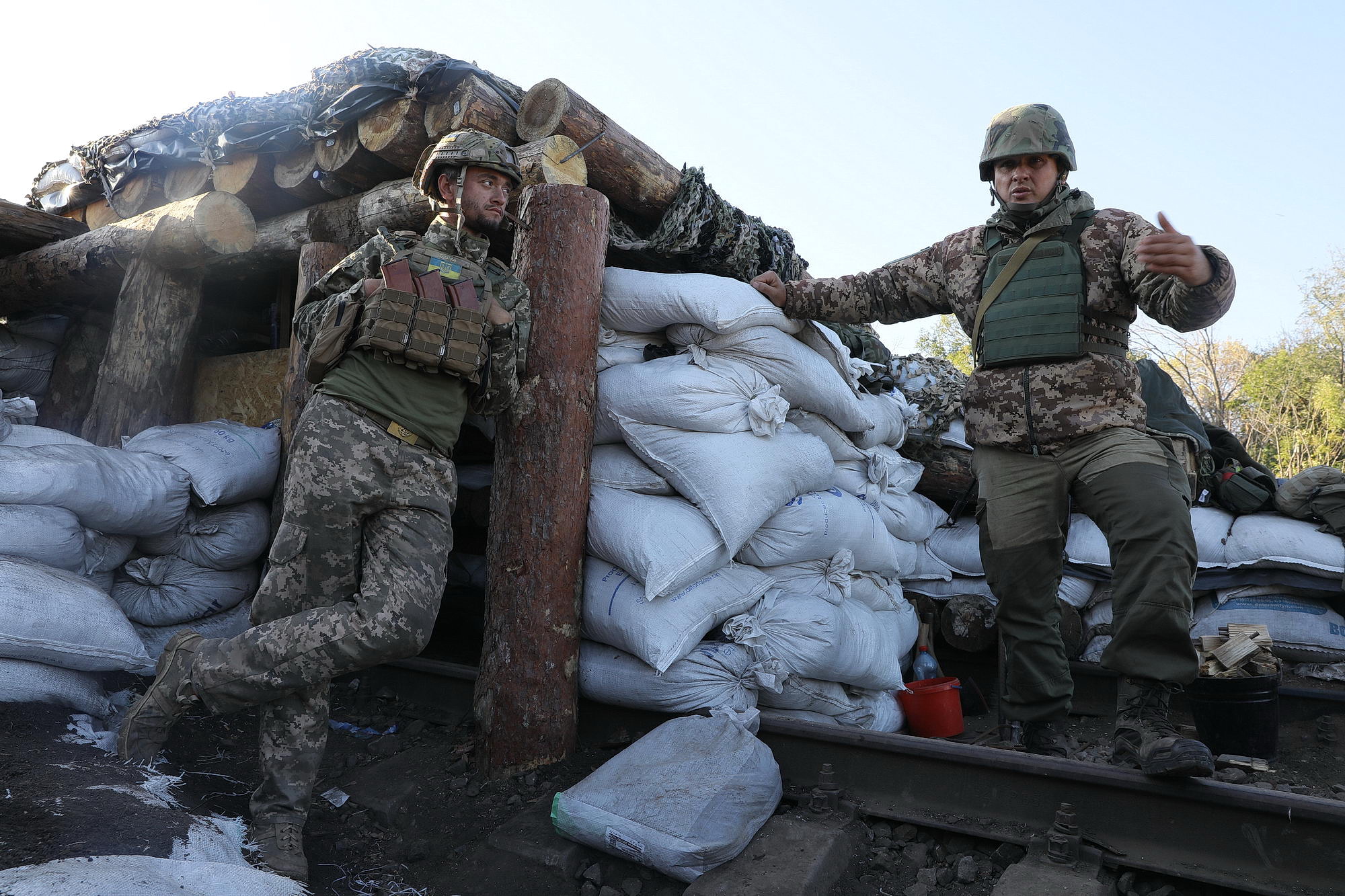The mutual withdrawal currently underway near the Donbas town of Zolote aims to ensure security for civilians living between the combat lines, the Ukrainian military stated during a press briefing on Oct. 29.
Earlier in the day, both Ukrainian forces and Russian-backed militants began a three-day process of pulling back troops and armaments in the town, which has seen frequent ceasefire violations since 2014. The process went forward despite reports of further shooting by the militants the day before.
The disengagement’s primary objective “is to create a safety zone one square kilometer in area at this location,” said Oleksandr Borschevskiy, leader of the Ukrainian party in the Joint Coordination and Control Center, a military liaison body between the lines in Donbas.
The central idea is to ensure that both sides’ forces withdraw from the direct contact zone, which will significantly reduce the probability of new armed clashes, he added. Prior to disengagement, the distance between the Ukrainian lines and the Russian-backed militants was roughly 500-600 meters.
If disengagement succeeds, the cross-front line entry point of Zolote, which has been effectively closed for civilian traffic since 2016 over security concerns, can resume full-time operation. In late July, the two sides successfully pulled back their forces near another front line checkpoint, Stanytsya Luhanska.
If the Zolote entry point is opened, it will become the first and only automobile travel path across the front line in Luhansk Oblast, Governor Serhiy Hayday stated on Oct. 29. The Stanytsia Luhanska point only has a pedestrian road.
Hayday even claimed that Russian-backed militants had given consent to open their side of the Zolote entry point.
Lieutenant General Volodymyr Kravchenko, the commanding officer of the Ukrainian combined military-police contingent in the war zone, also added that, should the enemy commit provocative acts during or after disengagement, the Ukrainian military would be ready to “ensure the protection of the civilian population.”
According to Kravchenko, the process of step-by-step mutual withdrawal should last three days until Nov. 1, when Ukraine’s Ministry of Foreign Affairs is expected to notify the Special Monitoring Mission of the Organization for Security and Cooperation in Europe (OSCE) that the disengagement has been accomplished.
Both sides indicated their readiness to begin the process at 12 p.m. local time by firing off white signal rockets. They then confirmed 15 minutes later by firing off green signal rockets. Starting at 12:20 local time, the first Ukrainian formation of 15 military servicepeople withdrew a kilometer back, the general said.
He noted that the Ukrainian military was not engaged in any direct talks with the enemy, using OSCE monitors as mediators instead.
Kravchenko also added that, during and after the end of mutual withdrawal, the demilitarized safety zone in Zolote will be patrolled by Ukraine’s National Guard and Border Service formations. Ukrainian local administrations and social services will continue to fully function in the area.
The OSCE Special Monitoring Mission later confirmed that both the Ukrainian army and Russian-backed militants were “exiting the disengagement area, together with their weapons.”

Soldiers of Ukraine’s 72nd Mechanized Infantry Brigade man a combat post in the front line town of Zolote on Sept. 11, 2019. (Oleg Petrasiuk)
Arsen Avakov, Ukraine’s Minister of Internal Affairs, said the situation in Zolote was “calm and controlled” as of the afternoon of Oct. 29. Police units and National Guard troops were fully prepared to ensure law and order in the town around the clock, he wrote on Twitter.
Speaking with journalists during an investment forum in Mariupol, Ukrainian President Volodymyr Zelensky said a successful disengagement in Zolote would raise the likelihood of a new meeting of the Normandy Four diplomatic group, which includes the leaders of France, Germany, Ukraine and Russia and aims to resolve the conflict. However, he stressed that the key point was not the meeting itself, but rather ensuring a sustained ceasefire in the war zone.
The primary goal of any disengagement of troops is reducing the probability of armed clashes, Zelensky said.
Former Ukrainian President Leonid Kuchma, the country’s envoy to the Minsk negotiations, also expressed his hope for an upcoming Normandy Four meeting where “a roadmap to reaching peace in Donbas may be negotiated,” his press secretary Darka Olifer said.
However, a political settlement — including local elections and granting the occupied territories broad autonomy — is possible only after enforcing the security component of the Minsk accords, which includes Ukraine regaining control over its border with Russia, Olifer added.
Meanwhile, the disengagement in Donbas was met with a new protest in Kyiv. Dozens of demonstrators, including active supporters of former President Petro Poroshenko, gathered near the Presidential Office on the evening of Oct. 29 for a rally called “Not one step back!”
Commenting on the withdrawal, Martin Sajdik, the OSCE envoy to the Mink negotiations, said the date to begin disengagement near yet another pre-agreed spot, the village of Petrivske in Donetsk Oblast, is yet to be negotiated.
Nonetheless, he added, the Minsk group continues its efforts to organize another prisoner swap between Ukraine and Russia. According to Ukrainian authorities, at least 360 Ukrainian captives are still being held in Russia and Russian-occupied Crimea and Donbas.
“We want to prepare a really big prisoner exchange,” Sajdik was quoted as saying on Oct. 29. “So we need to work on each person (held captive) to effectively define his or her destiny.”
